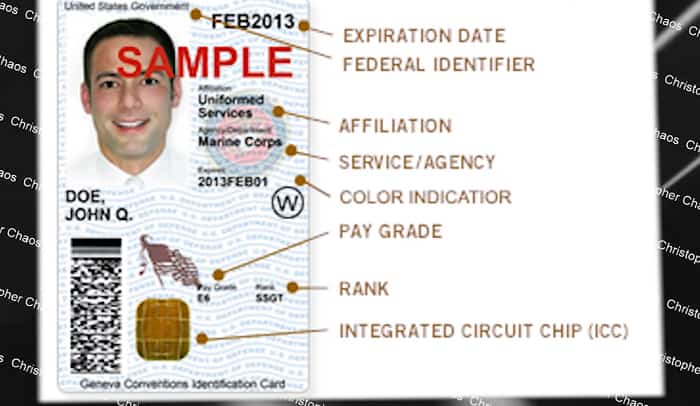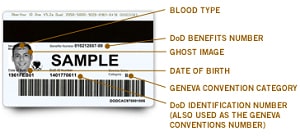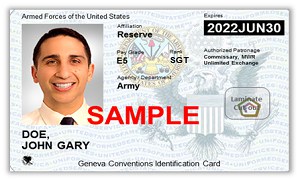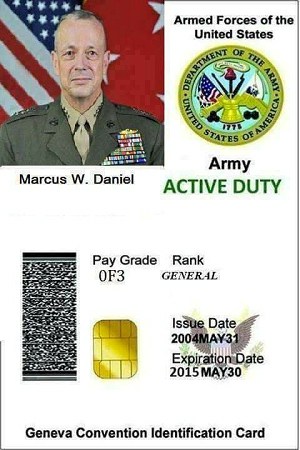How to spot a fake military ID card is a recurring topic on Reddit. As disappointing as the implications may be, it is still noteworthy that people are taking measures to prevent imposters. In this article, we will show you five steps to recognize a fake military ID card. So, you can arm yourself against frauds. Read closely!
Table of Contents
- 6 Steps to Identify Fake Military ID Cards
- Step 1: Know The Types, Who They Are For & What They Look Like
- Step 2: Do A Visual Examination of the Card
- Step 3: Do a Feel Test of the Card
- Step 4: Check The Information on the Card
- Step 5: Test the Cardholder Verbally
- Step 6: Look At Their Body Language & Behavior
- Recognizing Fake Military ID Cards – Online Dating Scams
- What Does a Fake Military ID Look Like?
- Conclusion
6 Steps to Identify Fake Military ID Cards
Step 1: Know The Types, Who They Are For & What They Look Like
There are many types of military ID cards, so it is crucial that you know them all. You should have an idea of what they look like and what their key features are.
Most fake military ID cards look completely different from actual cards because imposters rely on the fact that people outside of the military do not know what a real one looks like.
Common Access Card (CAC)
The standard ID card for members of the active duty force, Selected Reserve, and Department of Defense is the Common Access Card (CAC). It is about the size of a credit card.
The CAC is meant to give cardholders access to secured networks and systems and document affiliations.
There are four main types:
(1) Armed Forces of the United States Geneva Conventions Identification Card
This card displays the cardholder’s branch of service.
Cardholders include those in the:
- Active Duty Armed Forces
- Selected Reserves
- National Guard
- Reserve Officer Training Corps
- National Oceanic and Atmospheric Administration
- S Public Health Services
(2) U.S Department of Defense or Uniformed Services Identification Card
This card is for civilian employees, contractors, and affiliates who are granted access to DoD installations and systems. In detail, cardholders are:
- DoD and Uniformed Services Civilian Employees
- Eligible DoD, NOAA, and USCG Contractors
- State Employees (Supporting the National Guard)
- Intergovernmental Personnel Act Employees
- Federal Employees (Supporting the DoD)
(3) U.S DoD or Uniformed Services Geneva Conventions Identification Card for Civilians
This is for civilians accompanying the Armed Forces, such as emergency-essential civilian employees and contingency contractor personnel.
(4) U.S DoD and/or Uniformed Services Identification and Privilege Card
This card grants benefits and privileges to civilian employees, contractors, affiliates, and other personnel, such as:
- DoD and Uniformed Services Civilian Employees
- On a military installation
- When stationed or employed and residing in foreign countries for at least one year
- DoD Contractors
- When stationed or employed and residing in foreign countries for at least one year
- DoD Presidential Appointees
- Uniformed and Non-Uniformed Personnel of the Red Cross (Full-Time)
- When assigned to duty with the Uniformed Services
- When residing on a military installation or in foreign countries
There is a color coding system for the Common Access Cards.
- A BLUE bar is used for non-U.S citizens
- A GREEN bar is used for contractors
- A WHITE bar is used for all other personnel
Common Features of a CAC
On the front of the card, there should be:
- A photo on the left top corner
- An ame under the photo
- A bar code under the name
- An expiration date at the top right corner
- A Federal identifier at the top left corner (It is positioned slightly higher than the expiration date)
- An affiliation line (For example, a card could say “Uniformed Services.”)
- A service or agency line (For example, a card could say “Marine Corps.”) below the affiliation line
- A color indicator bar
- A pay grade line next to a rank line (The pay grade line is on the left; the rank line is on the right)
- An golden integrated circuit chip (ICC) under and to the left of the pay grade line
On the back of the card, you should find:
- The same photo on the right
- A DoD Benefits Number at the top of the photo
- A date of birth line under the photo
- A DoD Identification Number next to the date of birth line
- Also used as the Geneva Conventions Number
- A Geneva Convention Category next to the DoD Identification Number
- The same barcode at the bottom
Here is a picture sample of the card:
Aside from the CAC, there is the Next Generation Uniformed Services ID (USID) Card.
The Next Generation Uniformed Services ID (USID) Card
This is an ID card for military family members and military retirees. It provides access to service benefits and privileges. Starting on July 31, 2020. The card will also be issued to eligible individuals based on DoD’s policies.
There are three types:
(1) Armed Forces of the United States Geneva Conventions Identification Card
This is for members of the Individual Ready Reserves and Inactive National Guard. Civilian non-combat personnel who are not eligible for the CAC but are deployed to accompany military operations overseas can also have this card.
(2) U.S. Department of Defense or Uniformed Services Sponsor Identification and Privilege Card
Cardholders include:
- Retired members who are entitled to retired pay
- Retired members of the Reserves and National Guard
- Members of the Temporary Disability Retired List and Permanent Disability Retired List
- Recipients of the Medal of Honor
- Veterans who are 100% disabled
- Members of Transitional Health Care (TAMP)
- Full-time personnel of the United Service Organizations (USO) when serving OCONUS
- Personnel of the United Seamen’s Service (USS) OCONUS
- Officers and Crews of MSC vessels that are deployed to foreign countries
- Personnel of the Employer Support of the Guard and Reserve (ESGR)
(3) U.S. Department of Defense or Uniformed Services Dependent Identification and Privilege Card
This card is for dependents of:
- Active duty members of the Regular components
- Members of the Reserve component who are on active duty for more than 30 days
- Retirees
- Recipients of the Medal of Honor
- Veterans who are 100% disabled
- Members of Transitional Health Care (TAMP)
- Officers and Crews of MSC vessels that are deployed to foreign countries
- Members of the Reserve components who are not on active duty or are receiving retired pay
- Former members who are not receiving retired pay
as well as surviving dependents of:
- Active duty and retired members
- Recipients of the Medal of Honor
Non-U.S Citizen sponsors and their dependents have a blue color indicator, while white is reserved for current and former Uniformed Service Members, their Dependents, and all other personnel.
The new cards are printed on a plastic cardstock and look like this:
But the old ones (which are still valid until their respective expiration dates) have a different design. Here are the types:
- DD Form 2 (Reserve): This is for members of the Individual Ready Reserves and Inactive National Guard. It is the old version of the Armed Forces of the United States Geneva Conventions Identification Card.
- DD Form 2 (Retired): This is for retired members entitled to retired pay and members of the TDRL or PDRL. It is the old version of the United States Uniformed Services Identification Card.
- DD Form 2 (Reserve Retired): This is for retired members of the Reserve and National Guard under the age of 60. It is an old version of the United States Uniformed Services Identification Card.
- DD Form 1173: This is the old version of the United States Uniformed Services Identification and Privilege Card.
- DD Form 1173-1: This is the old version of the United States Uniformed Services Identification and Privilege Card for Guard and Reserve family members.
- DD Form 2765: This is the old version of the Department of Defense/Uniformed Services Identification and Privilege Card.
- Department of Defense (DoD) Civilian Retiree Card: This is for appropriated and non-appropriated civilian retirees of any DoD service, component, or agency.
Step 2: Do A Visual Examination of the Card
Take the card and do a general visual inspection of it. Look at its overall appearance, fonts, coloration, and key features. Here are the red flags of a fake U.S military ID card:
Red Flag 1: Inconsistent Fonts or Coloration
Skim through the prints on the card. If there are multiple different fonts on the card and the color patterns look oddly inconsistent, there is a good chance the card is fake. Also, check to see if there is any smudging or bleeding of the colors on the card. A real military ID card will not have either of these.
Red Flag 2: Spelling Mistakes
A real military ID card will not have spelling mistakes or typos. Therefore, if you notice these, your card is probably fake.
Red Flag 3: Sketchy Picture
The picture on the card should be a portrait photo showing the cardholder from the front view. It should also be against a plain white background.
Hence, if the photo on the card you are looking at has the person facing the side or there are items in the background, there is a good chance the card is fake. The person carrying it might have used photoshop to alter a fake military ID card template or blank military ID card they found online.
- Note: It is important to look at the back of the card as well. Make makers focus on replicating the front of the ID, not the back. So, it is easier to catch red flags by examining the back.
Step 3: Do a Feel Test of the Card
Hold the card and feel the front and back. You should run your fingers through the edges as well. Take note of any raised spots, ridges, bumps, and irregularities. Check if there are physical alterations that can suggest tampering like overlays or glue lines. Also, try peeling the corners with your nail. A real card cannot be split or peeled back.
Step 4: Check The Information on the Card
Red Flag 1: Mismatched Picture
You should compare the person giving you the card with the picture on the ID. This may sound like a “duh” step but many fake military ID holders actually count on the fact that you are too busy to inspect the ID’s details closely. If there are discrepancies, question them directly.
Red Flag 2: Mismatched Pay Grade & Rank
Most military posers do not know enough about the military, including knowledge of the pay grades and ranks. Typically, they slap the wrong information on their fake cards and give it away!
For instance, they might state 0F9 pay grade and General rank, while 0F9 is for the Major rank.
So, you just need to be a bit more attentive!
If you have a feeling the military ID card is fake, ask them to give you their signature and compare it to the one on the card.
Step 5: Test the Cardholder Verbally
While holding the ID, ask the person about their personal data. If they are a fake card maker, they will not be able to respond without hesitation. In addition, you can try to purposely mispronounce their name and misstate their details to see if they instinctively correct you with the right information.
Step 6: Look At Their Body Language & Behavior
Recognizing a military poser by observing their body language and behavior is possible. The typical signs to look at are:
- avoiding eye contact
- showing hesitation while answering
- attempting to intimidate or appear indifferent
Imposters do care about facing a fake military ID penalty, so their bodies will likely show that they are nervous or worried.
Recognizing Fake Military ID Cards – Online Dating Scams
Online dating scams are other common application of fake military ID cards. In this case, the clearest red flag is if the cardholder sends you the card. It is against the law to do this, so if they try to prove to you that they are actual service members by mailing you their card, they are imposters!
What Does a Fake Military ID Look Like?
Here is an example of a fake us Army ID card:
You can tell this is an Army fake military ID card because OF3 is the pay grade for a Major (MAJ) rank and not General.
If you search, military ID cards online you will find many versions of military cards, including fake retired military ID cards and fake veterans ID cards. Hence, it will be difficult to distinguish between a real and a fake one.
Conclusion
Now, you know how to spot a fake military ID card. We have simplified the process to just five steps so we hope that you can easily apply what you have read. If you have other tips, share them in the comments to help other readers!

I am Everett Bledsoe, taking on the responsibility of content producer for The Soldiers Project. My purpose in this project is to give honest reviews on the gear utilized and tested over time. Of course, you cannot go wrong when checking out our package of information and guide, too, as they come from reliable sources and years of experience.







